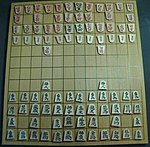Micro shogi

Microshogi (五分摩訶将棋 gofun maka shōgi "5-minute (scarlet) poppy chess") is a modern variant of shogi (Japanese chess), with very different rules for promotion, and demotion. Kerry Handscomb of NOST[note 1] gave it this English name. Although not confirmed, he credits its invention to the late Oyama Yasuharu, one of the most famous professional shogi players in history. In the mid-1980s, Handscomb was gifted a set custom made by a Japanese craftsman. Therefore, the game must have been invented before this time.
Equipment
Two players play on a board ruled into a grid of 5 ranks (rows) by 4 files (columns). The squares are undifferentiated by marking or color.
Each player has a set of 5 wedge-shaped pieces. The pieces are of slightly different sizes. From largest to smallest (or most to least powerful) they are:
- 1 king
- 1 bishop
- 1 gold general
- 1 silver general
- 1 pawn
The king is blank on the opposite side, the silver has a lance on the opposite side, the gold a rook, the bishop a tokin, and the pawn a knight.
The pieces all move like their shogi equivalents.
Game rules
The game is identical to standard shogi with the following exceptions.
Setup
|
|
Each side places his pieces in the following positions, pointing toward the opponent. For more information see the ChessVariants.com page on micro shogi.
- In the rank nearest the player:
- The king is placed in the right corner
- The bishop is placed in the adjacent file to the king.
- The gold general is placed adjacent to the bishop.
- The silver general is placed adjacent to the gold general in the left corner.
That is, the first rank is |S|G|B|K|.
- In the second rank, each player places the pawn in the same file as the king.
Promotion
Unlike standard shogi, microshogi has no promotion zone. Instead, a piece promotes when it captures, and promotion is mandatory. When a piece captures, it is flipped over to show the value on the other side.
Promotion values are entirely different from standard shogi:
- A king does not promote: K
- A silver general becomes a lance and vice versa: S ↔ L
- A bishop becomes a tokin (T) and vice versa: B ↔ T
- A gold general becomes a rook and vice versa: G ↔ R
- A pawn becomes a knight and vice versa: P ↔ N
Likewise, when a lance, tokin, rook, or knight makes a capture, it flips back to its former state.
A piece can flip back and forth during the game as it makes captures.
A knight which reaches one of the two far ranks is trapped, as is a pawn which captures and thus promotes there. Likewise, a pawn that reaches the far rank is trapped, as is a knight which captures there. A lance is also trapped at the far rank, but can escape if it captures there and thus promotes to a silver. A silver which captures in the far rank and therefore promotes to a lance is trapped.
Any trapped piece may be captured and returned to play as part of the opposing army.
A tokin moves the same way as a golden general.
Drops
Drops are similar to standard shogi, except that:
- A player may drop a piece with either side facing up.
- There are no restrictions when dropping pawns. That is, a player may have two unpromoted pawns on the same file, a piece can be dropped with no legal moves later, and a pawn can be dropped to give immediate checkmate.
See also
- Shogi variant
- Tori shogi
- Minishogi
- Judkins shogi
- Kyoto shogi
- Cannon shogi
- Yari shogi
Notes
- ^ NOST (kNights of the Square Table), a (now defunct) correspondence game club formed in 1960 by Bob Lauzon and Jim France, enjoyed several hundred active members.
External links
- Shogi Net
- Shogi: Japanese Chess
- Chessvariants.com
- v
- t
- e
- Dōbutsu shōgi (3×4, for children)
- Micro shōgi (4×5)
- Minishōgi (5×5)
- Kyoto shōgi (5×5)
- Goro goro shōgi (5×6)
- Janken shōgi (6×6; ja, zh)
- Judkins shōgi (6×6)
- Whale shōgi (6×6)
- Tori shōgi (7×7)
- Yari shōgi (7×9)
- EuroShogi (8×8)
- Heian shōgi (8×8 or 9×8, 12th c.)

- Sho shōgi (9×9, 16th c.)
- Hasami shōgi (9×9, 9 or 18 pc.)
- Tobi shōgi (9×9; zh)
- Annan shōgi (9×9, neighbors influence movement)
- Masonic shōgi (9×9, staggered ranks)
- Hexshōgi (85 hex cells)
- Kawanakajima shōgi (ja)
- Trishōgi (9×10, triangular cells)
- Kyō shōgi (10×10; ja)
- Okisaki shōgi (10×10)
- Great whale shōgi (11×11)
- Oni shōgi (11×11; zh)
- Wa shōgi (11×11)
- Chu shōgi (12×12)
- Heian dai shōgi (13×13)
- Dai shōgi (15×15)
- Tenjiku shōgi (16×16)
- Dai-dai shōgi (17×17)
- Maka-dai-dai shōgi (19×19)
- Hishigata shōgi (19×19)
- Kō shōgi (19×19)
- Tai shōgi (25×25)
- Taikyoku shōgi (36×36)
- Sannin shōgi (hex board, 7 cells per side, 3-player game)
- Yonin shōgi (9×9, 4-player game)
- Space shōgi (9×9×9 variant)
- Gunjin Shōgi (various sizes)









